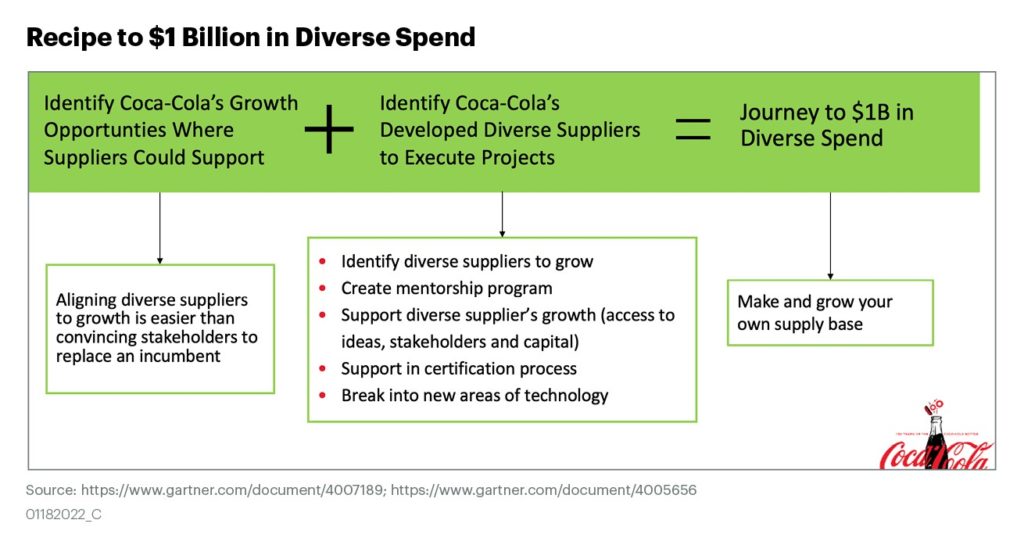As leaders look to understand what sustainable profit means for their organizations, sourcing and procurement professionals are exploring the roles they can play in the sustainability agenda, using levers such as supplier diversity.
We recently had the opportunity to work with Fernando Hernandez, the senior director of supplier diversity, global procurement at The Coca-Cola Company, on a set of videos focusing on best practices Fernando has collected along with his robust supplier diversity career.
Here are a few highlights Fernando shared on Getting to a Billion Dollars in Supplier Diversity Spend: An Outcome-Based Program and Building a Global Supplier Diversity Program.
Achieve lofty supplier diversity goals through company growth
When launching a supplier diversity program, companies will often look to understand which current spend can be converted over to diverse suppliers.
Switching away from incumbents, however, requires an immense amount of influence and may not always be the best business practice — especially if the incumbent is performing well.
Coca-Cola avoids this problem by focusing diverse spending on business growth areas, where a new supplier will need to be qualified. These growth opportunities — especially when breaking into a new area of technology — give Coca-Cola the bandwidth to identify, qualify and prepare a diverse supplier to win the bid (see more about Coca-Cola’s journey to $1 billion in diverse spend in Figure 1).
They focus on bids that are around the $5 million mark, which is their sweet spot to move the needle in their supplier diversity goals; typically, we hear this sweet spot ranges from $1 million to $5 million for large-cap companies.

Sustain program momentum by building both company- and community-impact business cases
While supplier diversity has been a hot topic since mid-2020, our volume of inquiries on the topic exploded by 500% last year. With so many competing priorities, companies need to report on program performance through outcome-oriented benefits — both company and community impact.
Company impact includes, but is not limited to, new revenue from federal, state and local requirements/contracts and innovation, as well as cost reduction from increased competition and efficiency through agility.
In these times of supply chain shortages, we’ve heard dozens of stories on how small, agile and diverse businesses have helped our clients through access to materials.
Community impact typically includes a number of jobs (every $1 million in diverse spend is approximately 17 jobs) and economic impacts ($1 in diverse spend is about $1.97 in economic impact). It’s more likely for a supplier diversity program to continue to be invested in if the ROI is positive and communicated.
Build a global supplier diversity program by prioritizing countries with high revenue (for b2c) or high spend and passionate boots on the ground
Unfortunately, a global one-size-fits-all supplier diversity program strategy is impossible to build due to regional differences, such as how diversity is defined.
After prioritizing the region to expand your program, Hernandez recommends cocreating an in-region strategy by integrating business priorities alongside the region’s realities, as the local staff will be owning the relationships in this program.
Regional realities are defined as an understanding of the current state of operations, the context of DEI more broadly, the political landscape and the existing NGOs/academia (additional context provided below in Figure 2).
The level of effort to build a program will differ drastically based on the maturity of diversity in the country – varying from some countries having certifying bodies to other countries with laws against collecting confidential demographic data such as ethnicity.

Gain quick global traction through partnering with existing certifying bodies
Since customizing a global supplier diversity program can be quite a time consuming, companies will often partner with third-party organizations dedicated to supplier diversity, such as WEConnect International or the Global Supplier Diversity Alliance.
For building a global supplier diversity program, Hernandez begins by creating a program with women-owned businesses, due to the ethnic and cultural complexity of each unique market. Typically, only after working with WeConnect, WPO and IWEC, do they continue to expand a regional program into other areas of diversity.
While supplier diversity is absolutely a commitment, we appreciate all companies who have made a choice to invest in the cause, especially the companies we have profiled for their cool initiatives such as Coca-Cola, FirstRand, Intel, Cummins, Humana and CDW.
First published on Gartner’s Power of the Profession Blog





